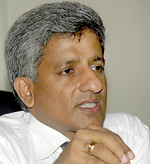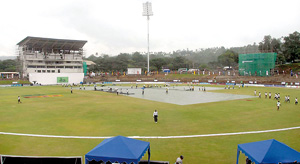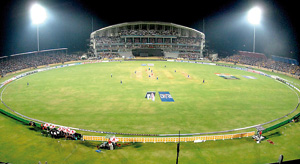Definitely it was not December 21, 2012. Yes, it was April 2, 2011 and it was at the Wankhede Stadium Mumbai. Without reservations, we say the Sri Lankans on that fateful day lost the Cricket World Cup through their own seeking on on-field occurrences, largely in the area of fielding. Through the final round the Lankan fielding had been loose, yet they managed to get away to the final.
 But, in a final against a batting line-up like India, if you miss half a chance you end up becoming history. With all due respect to the doomsday prophets, there may not have been conspiracies or back stabbing, yet Sri Lanka lost the match. When you face a situation of the nature of losing a much-awaited cricket final, followed by the resignations of the captain, the vice captain, the selection committee, the national coach and even the bus driver, you got to mend the fences as quickly as possible and look beyond and see from where we should go and how we should do it. There is no point dwelling upon the spilled milk because you cannot drink it. But, in a final against a batting line-up like India, if you miss half a chance you end up becoming history. With all due respect to the doomsday prophets, there may not have been conspiracies or back stabbing, yet Sri Lanka lost the match. When you face a situation of the nature of losing a much-awaited cricket final, followed by the resignations of the captain, the vice captain, the selection committee, the national coach and even the bus driver, you got to mend the fences as quickly as possible and look beyond and see from where we should go and how we should do it. There is no point dwelling upon the spilled milk because you cannot drink it.
 |
| Nishantha Ranatunga explaining on what’s to come. |
By mercy or by mistake, the custodians of the game -- the hierarchy of Sri Lanka Cricket or the Cricket Interim Committee -- remain untouched. It is now up to them to provide the answers to policy questions how they would look at this situation. They should also reveal their answers to the intricate questions and at the same time tell us how they will find the path to the short term, the medium term and the long term cricketing goals.
So the Musings turned towards one of the main custodians -- IC Secretary Nishantha Ranatunga -- to find their stand on the present macabre situation.
The first question was about how they were planning to untangle the mess-up. The SLC secretary began by saying, “When we took office in April 2009, we looked at the coming World Cup very closely. At the same time, there were other hurdles also to clear. Initially, Sri Lanka was to host eight World Cup matches. At the inception the ICC wanted only two Sri Lankan venues, but later the number of venues increased to three because we got four more matches. This was a direct result of the ICC ruling out Pakistan as a host.
“There were certain guidelines set upon us with regard to the facilities for the players, the officials and the media akin to an ICC event. So we had to take a rational decision to spend money on these three venues and the selection was the first priority. Then the IC in consultation with some other important policy makers decided to develop our own grounds. We also decided to develop these venues with the minimum expenses and maximum facilities. The idea behind this is to take the game out of Colombo and promote it in the little known hubs during the World Cup.
“So the with the Premadasa Stadium as the main venue, the other two new venues in Hambantota and Pallekelle were launched. Our objectives of having state-of-the-art facilities conforming to ICC criteria were achieved.”
Ranatunga said the new venues were not short-term investments but they have been developed for the future of the game in the country with the aim of uplifting the game in the outstations which now has become the main talent provider to the national grid.
When asked as to who footed the bill for the building of these grounds, Ranatunga said it was the SLC which had to look after the expenses to build these stadiums. Then when asked as to how the standards of these grounds would be maintained at their present level, the answer was: “When we built these grounds a lot of people asked the same question. Our objective is to run these facilities as profit centres. For example there are 115 countries which are playing cricket at present, besides the full member states. We want to develop different academies at these centres – like a spin academy, batting academy and a fast bowling academy Our coaches will be utilized to man these academies.”
The IC secretary also added that these venues will be utilized for next year’s T-20 World Championships which will be held in Sri Lanka and the Hambantota Stadium will be used as the main venue for the next Commonwealth Games if it comes through. “Besides this, Sri Lanka has indicated to all stakeholders that our grounds are available, if they are planning to have an exchange in a neutral venue. Sri Lanka has got a very favourable response to the offer to facilitate the Pakistan-England series in early 2012.”
Moving on to another intricate issue on recalling the players for the England tour from the IPL, Ranatunga said, “Firstly, the decision to recall the players was a cricketing one. For the England tour, Sri Lanka would have a new captain a new vice captain and a new coach. So on that background it is good for them to practise together for a few days prior to their departure. In fact, it was the new selectors led by Duleep Mendis who wanted this done. Besides that, in England it will be the Test matches that will be played first so it is important that they get into that frame of mind too. As administrators it is our duty to explain matters to the Indian authorities and keep our cricketing relationships cordial.”
In explanation to the structured cricket policy of short-term, mid-term and long-term, Ranatunga said that in the short-term the England tour at hand will be very important for Sri Lanka. Right now Sri Lanka is in the third position of the ICC Test rankings. Sri Lanka will have to do well in this tour, if they are to find a position in the inaugural World Test Champions that will be worked off in England in 2013. The first four teams in the ICC rankings at the end of 2011 will play in the championships which will take off from the semi-final stage onwards.
“If Sri Lanka wins the series against England in England they will move into the second position. In the mid-term Sri Lanka will have to build a team that could face the T-20 World Championships that will be played in Sri Lanka next year and in the long-term, we want to build up the Lankan team to face the 2015 World Cup.”
He then explained that while we engage in the top activities, accent should also be cast upon the building of the junior teams and junior tours along with the sustenance of the domestic structure.
He added that SLC would also seriously look at the possibility of having a long-term coach and a long-term cricket manager.
Then came the urchin’s wound. One of the main accusations against SLC is that they are in the red with a debt of over US$ 23 million. If the SLC is bent on achieving all these goals mentioned above and how they are going to survive with a debt burden of this nature, the Musings asked. The Musings also pointed out that the SLC treasurer had described the present problem only as a cash flow shortage.
Ranatunga replied: “I agree with the SLC treasurer. Sri Lanka Cricket is not a venture where you get money every month like normal businesses. This is not sales-oriented or service oriented. SLC’s money comes seasonally. For instance when India, Australia or England plays Sri Lanka the coffers get high; when we have ICC events the financial status improve. The onus is on us to make sure that this income that we get is properly utilized. For instance, if you do not have good events and promotions the awareness of the game will not be there, so we aim to build at least at least one cricketing centre in every province within the next two years and provide the same facilities that are available in Colombo to the outstation cricketers. Right now 80 percent of the cricket talent comes from the outstations and in this manner, the flow may be increased.
“Then in the case of finances, they are well managed and any investment that is made goes through the proper channels so that it brings revenue. There is an ICC payment that has to come in; then the Pakistan-England series and the next T-20 championship will bring us revenue. Besides that, there are other side incomes like secondary sides that would come and play here and use our facilities. They also bring in a substantial amount of money.
“Finally once the academies are on the road, they will also get us a substantial income. Then automatically we could maintain the grounds as well as pay back our outstanding loans. Without the loans we could not have built these facilities and without these facilities we cannot take the game forward in the country.”
The IC secretary also said the auditing of accounts for 2009 is already completed and the 2010 audit is being done by the Finance Ministry’s treasury department, and they hope to release these accounts shortly.
 |
 |
| The three main cricket stadiums at Pallekelle, Hambantota and in Colombo will be turned into profit centres. (Pictures by Sanka Vidanagama) |
|

 But, in a final against a batting line-up like India, if you miss half a chance you end up becoming history. With all due respect to the doomsday prophets, there may not have been conspiracies or back stabbing, yet Sri Lanka lost the match. When you face a situation of the nature of losing a much-awaited cricket final, followed by the resignations of the captain, the vice captain, the selection committee, the national coach and even the bus driver, you got to mend the fences as quickly as possible and look beyond and see from where we should go and how we should do it. There is no point dwelling upon the spilled milk because you cannot drink it.
But, in a final against a batting line-up like India, if you miss half a chance you end up becoming history. With all due respect to the doomsday prophets, there may not have been conspiracies or back stabbing, yet Sri Lanka lost the match. When you face a situation of the nature of losing a much-awaited cricket final, followed by the resignations of the captain, the vice captain, the selection committee, the national coach and even the bus driver, you got to mend the fences as quickly as possible and look beyond and see from where we should go and how we should do it. There is no point dwelling upon the spilled milk because you cannot drink it. 


